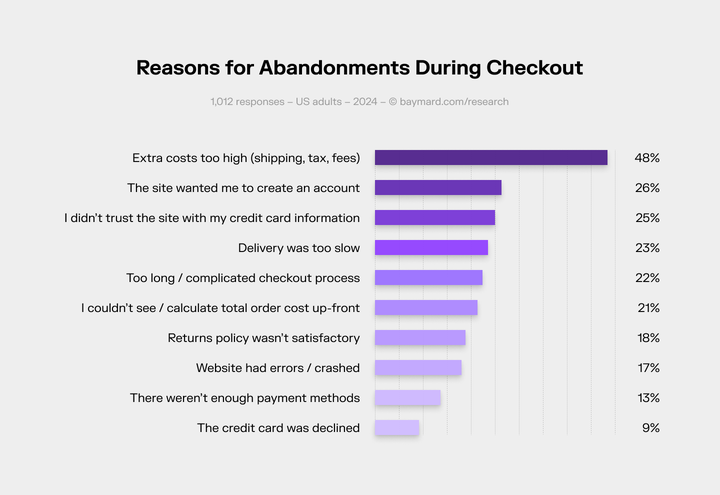How to Reduce Cart Abandonment in Your Online Store

If you’re the owner of an ecommerce business, you probably already know a thing or two about cart abandonment.
It happens when customers add an item to their shopping carts but ultimately decide against completing their purchase.
Although the causes of cart abandonment are multifaceted, it’s essential for businesses to understand this problem and implement strategies to minimize its impact on their revenue.
In this article, we’ll delve deeper into the topic of cart abandonment, outlining how and why it happens, as well as offering some actionable tips to reduce the number of abandoned carts in your online store.
How cart abandonment affects you
Let’s kick things off by looking at a few statistics to fully understand the extent to which cart abandonment negatively impacts businesses.
The latest research from the Baymard Institute shows that the average documented online shopping cart abandonment rate currently sits at a staggering 70.19%.
That’s just over seven out of ten customers that leave without finalizing their order!
But how does that percentage impact your store’s revenue?
Imagine your average customer spends $100 per order and your store has around 200 potential buyers each month. Well, according to the statistic above, over 70% of those carts will get abandoned, leaving you with 30% that will actually complete their purchase. That’s 140 abandoned carts—or $14,000 in lost sales.
This shocking statistic highlights the need for a more proactive approach in reducing cart abandonment.
Top reasons customers don’t complete their transactions
Before making any changes, try to identify why people are abandoning their carts to begin with.

Based on the Baymard Institute’s 2023 study, the primary reason why customers abandon their cart is the extra costs on shipping, taxes and other unexpected fees.
26% of responses cited that having to register an account or enter personal details on the site is the reason they refused to complete their purchase.
Lucky for us, these are all things businesses can easily remedy just by making a few changes to their store, such as offering free or flat-rate shipping or including a guest checkout option.
Proven ways to reduce cart abandonment
Now that we know why customers don’t complete their purchases, let’s look at six things you can do to help reduce cart abandonment rate in your store.
1. Keep your shipping costs low

Online store owners should accept that companies like Amazon have already normalized free shipping.
By offering similar incentives, you can keep your customers satisfied and meet one of their key expectations, thus reducing the likelihood of cart abandonment.We understand it’s impossible for smaller merchants to offer free shipping, but there are plenty of workarounds, like discounted deliveries when a customer spends over a certain amount in your store.
You can also try factoring the average shipping cost into your product price, making shipping seem “free” even if it really isn’t.
No one method will work the same for every store, so it’s important to find that perfect balance that lets you keep your profit while still enticing customers.
2. Offer a guest checkout for quicker purchases

Adding a guest checkout option is an easy fix to reclaim some of your abandoned carts.
Most customers don’t want to register for accounts during the checkout process, as many consider it to be a tedious and time-consuming step.
By providing the convenience of a guest checkout, you create a more seamless experience, which encourages more completed transactions.
You can always offer the option to create an account after the customer makes their purchase, ensuring that both privacy-conscious shoppers and those seeking a faster checkout process feel comfortable.
3. Make sure your store has all the popular delivery options

This tip ties in with the first, especially since Amazon and other big businesses have such impressive logistics and shipping times.
Most of your customers will unfortunately be used to this kind of service, so it’s important to offer the usual array of delivery times to cater to every need.Faster delivery may mean the shipping cost spikes, but some customers would rather pay more to have their order home sooner, while others prefer to wait and minimize their shipping costs.
By including faster options alongside the standard ones, you cater to shoppers with varying degrees of patience and ensure that even those who value instant gratification feel good about their wait time.
4. Build trust with your customers

If you want to reduce cart abandonment in your online store, it’s crucial to address the customers’ concerns about trusting your website.
One simple but effective strategy is to ensure that your store uses a secure connection, which provides customers with a safe, encrypted connection between their browser and your store.
With an HTTPS certificate, your customers have a reliable way to verify they’re connecting to the right web server and not a fake scam website.
Another key aspect is the design and quality of your store’s website. A professional brand can help build trust in both existing and potential customers.
Businesses should only use high-quality images, matching colors and fonts, and a well-thought out UI that makes your store easy to navigate.
Try to provide as many contact methods as you can and make sure your privacy policy and terms of service are easily accessible and updated. By being transparent about how you handle customer data, you can really ease any concerns customers may have about the security of their personal information.
Finally, why not consider incorporating elements like customer reviews, testimonials, and secure payment logos to further enhance your store’s credibility? This will encourage customers to complete their purchases without having second thoughts about who they’re actually buying from.
5. Streamline your checkout process

Long checkout processes can drive customers away from completing their purchase.
To fix this, try to minimize the number of mandatory form fields for customers to fill out. Ideally, the only necessary fields are those that allow you to ship their order and the ones that allow them to track it.
To improve on this even further, you could implement auto-fill for fields such as addresses. Having the option to select the same shipping and billing address is a big bonus that saves the customer’s time by preventing them from filling the information out twice.
Alternatively, you could remove the form fields altogether by integrating ShopPay into your store. This is a Shopify owned service that acts like an online wallet—it stores customers’ shipping information and payment methods, allowing for a wholly efficient, one-tap checkout process.
Other similar services to include in your payment options would be PayPal, GooglePay and ApplePay, all of which offer a more streamlined checkout.
6. Make refunds easy

To create more trust and confidence in your brand, it’s important to have a clear and easily accessible returns policy that reassures your customers about your hassle-free returns process.
For those of you on Shopify, the platform offers its own valuable tool to help with your returns policy—the self-serve returns feature.
Self-serve returns allow your customers to start and manage returns independently instead of contacting you directly. If customers were to contact you, you would need to handle the return request manually, so Shopify saves time for both parties in this case.
Using this, you can then approve or decline requests in your Shopify admin dashboard, where you’ll find further steps explained in more detail.
Returns that are this easy to navigate are sure to instill confidence in your brand, meaning customers are less likely to abandon their carts.
Recovering abandoned carts in your store

Even if you implement all of the strategies we outlined above, abandoned carts are still bound to pop up every now and again.
Don’t lose hope, though, since you can still try a few recovery tactics to motivate customers to come back and finalize their purchase. Here are a few methods to do this.
- Timely email reminders—send a series of automated emails to customers who left their carts unattended for a certain period. Start with a gentle reminder about the items they have left behind and follow up with additional discounts or promotions to entice them back to complete their purchase.
- Push notifications—when reminding customers who use mobile devices or web browsers that support push notifications, you can leverage this channel to send a nudge about the items in their cart. These notifications are short and attention-grabbing, which can pique the customer’s interest at just the right time and lead them back to your store.
- Exit popups—by tracking a customer’s mouse movements, you can present a targeted message as they are about to leave their cart (or your site). These messages can offer a discount or incentives to encourage them to stay and finish their purchase.
- Live chat—sometimes customers abandon their carts because they have a couple of unanswered questions, but don’t want to go through the trouble of emailing a store. By being proactive and available when they need help, you increase the likelihood of converting an abandoned cart into an order.
- Personalized abandonment emails—to work in tandem with the aforementioned email reminders, use the data you have on customers to create personalized emails for each abandoned cart scenario. This level of personalization can make customers feel valued and more likely to return to their cart.
- Urgency campaigns—Create a sense of urgency by offering limited-time discounts or promotions, such as free shipping on orders placed within the next twelve hours. These can motivate customers to buy quickly so they don’t miss out on anything.
Using your store’s statistics to your advantage
Incorporating a combination of the strategies we outlined is essential for tackling cart abandonment.
However, no one way works for every store. It’s crucial to remember your niche will have unique needs and customer behaviors.
To maximize the effectiveness of your recovery efforts, work to analyze your store’s specific abandoned cart data and tailor these tactics accordingly. Large ecommerce platforms like BigCommerce and Shopify should make the process easier thanks to their inbuilt analytics.
By focusing on your own data, you can create targeted campaigns that resonate with not just any audience, but specifically your audience.
Professional invoices for Shopify stores
Let Sufio automatically create and send beautiful invoices for every order in your store.
Install Sufio - Automatic Invoices from the Shopify App Store